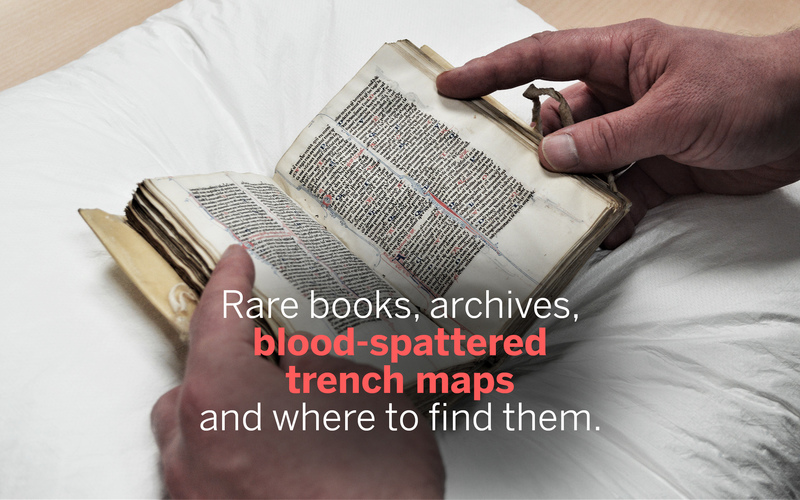Rare books, archives, blood-spattered trench maps and where to find them.
Among the collections, you’ll find a blood-spattered trench map, personal diaries, including Farley Mowat’s research journal with mosquitoes squished inside...
In the basement of the Mills Memorial Library, removed from general foot traffic, you’ll find the William Ready Division of Archives and Research Collections. The principal repository for rare books, archives, antiquarian maps, and related historical material at McMaster University, it welcomes specialized scholars from all over the world who are interested in the division's strong collecting areas, including 18th century books and journals, Canadian literature and publishing, and pacifism and peace movements.
For Archives and Rare Books Librarian Myron Groover, making the repository a more welcoming space for members of the McMaster and Hamilton communities is a primary focus that involves using education and community engagement opportunities to lower perceived barriers that prevent people from accessing the division's holdings.
“We have a good sort of problem here, which is that we have one of the strongest archival and rare book collections probably of any Canadian university, but historically we haven’t seen as much engagement with the material, particularly on campus and in the city as we would like,” says Groover, who says he would love to see more members of the general public visit the library and archives.
“I think archives and reading rooms and special collections departments can be inherently kind of imposing or forbidding spaces for a lot of people,” says Groover who is hoping to shift the way we think about and engage with archival material. “It’s really important to bring people into the physical space and to get them to interact directly with the artefacts and realize that resources like this are within your reach,” he says.
One way Groover and his colleagues are hoping to dismantle barriers is doing more and more teaching on campus, and connecting to what students and faculties are already doing. “We have a collection that is phenomenally rich and broad in scope and it’s able to support a lot of undergraduate learning,” says Groover, who is especially excited about the opportunities material can offer artists on campus and beyond.
“By nature any book published prior to the year 1800 is in the public domain. That means it’s unencumbered by copyright. As long as the book is in good enough condition for someone to use it, I’m interested in getting more visual artists, graphic artists, to come in,” says Groover. “Bring in an SLR, take a high-resolution photo of an 18th century copper plate engraving, or of a piece of typesetting or of a woodcut and do whatever you want with it. It’s not even a question of us licensing it to you. It’s in the public domain, which means the content belongs to everyone.”
“Bring in an SLR, take a high-resolution photo of an 18th century copper plate engraving, or of a piece of typesetting or of a woodcut and do whatever you want with it."
There’s a misconception that archives are just stacks of papers; however, the team at the William Ready Division of Archives and Research Collections are ready to debunk that. Among the collection’s many prized possessions are Bertrand Russell’s Nobel Prize in Literature and Jackie Washington’s guitar. Of course, a lot of paper can be found in the division's holdings, but paper doesn’t have to be dull. Among the collections, you’ll find a blood-spattered trench map, personal diaries, including Farley Mowat’s research journal with mosquitoes squished inside, and the fonds of many notable Canadian writers, including Austin Clarke and Margaret Laurence.
Most famously, the archive and personal library of famed philosopher and peace activist Bertrand Russell have been housed McMaster University Library since 1968 (Now at the Bertrand Russell Archives and Research Centre). More recently, before his death, beloved storyteller Stuart McLean donated his personal and literary archive, which includes manuscripts, photographs, fan mail, and sound recordings, to the division. Some of this archive is currently on display outside the division’s reading room.
“We have two sides to what we do here. One is that we have a library of books, many of which are rare books printed prior to the year 1800,” says Groover, who notes that of the approximately 100,000 volumes in the rare books collection, 30,000 of those or more were printed prior to 1800. The constantly growing collection ranges from 12th century material to books that were published this year. The division’s archives collection is comprised of approximately four linear kilometres of material.
One thing that makes the William Ready Division of Archives and Research Collections unique is that it still has a conservation lab and full-time conservator who is dedicated to safeguarding the physical longevity of artefacts. Much of conservation work at other universities is now outsourced to the private sector, which can be costly. Groover says that the three major deteriorative factors for most material media are light, humidity, and temperature. “We’re trying to minimize the ambient suffering to which the material is subjected,” he says.
WATCH: The restoration of "The Book of Hours" a 545-year old book currently housed at McMaster.
What likely strikes most visitors to the William Ready Division of Archives and Research Collections is how accessible rare books and archival material are. On my first visit, within minutes of handing over my photo ID, I was handed a guest researcher card and a box of correspondence between Leonard Cohen and famed Canadian publisher Jack McClelland. Before visiting, Groover suggests using the thorough searchable online database and getting in touch with staff in advance so they can have any materials of interest waiting for you. He also encourages tours of the archives and research collections. (Wonder what it would be like to hold a 500-year-old book in your hands? This is your chance!)
“We’re proud to be open to the public,” says Groover. “The way we think of what we do is we’re holding these material in trust for all of humankind.”

